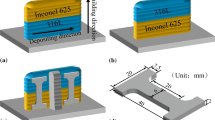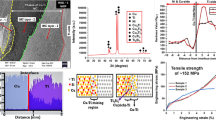Abstract
Inconel 625 (In625) is preferred under the circumstances where high strength and corrosion resistance at elevated temperatures are required. However, the restricted thermal conductivity constrains the application of In625 in high heat flux cases. The joining of materials with high thermal conductivity to In625 is capable of improving upon this limitation so as to adapt for temperature-sensitive requirements. In this study, a bi-metallic structure was fabricated by joining In625 on Copper 110 (Cu) substrate with directed energy deposition. Material examination indicated no crack and minor porosity were detected through and along the interface of two materials and the following as-deposited In625. Mechanical performances were characterized at both as-deposited and heat-treated conditions. The resultant yield strength and ultimate tensile strength of as-deposited In625 was 670.97 ± 5.43 MPa and 925.36 ± 9.90 MPa, respectively, with a mean maximum elongation of 0.416 mm/mm. Slightly decreases (by ~ 5%) in tensile strength were observed after heat treatment under 500 °C for 24 h with an enhancement in elongation by ~ 6%. Ductile fracture mode was observed on the fracture surfaces of broken tensile specimens. The impact toughness for as-deposited In625 and heat-treated In625 (under 600° for 24 h) was 118.058 ± 2.285 and 112.045 ± 5.755 J, respectively. A significant improvement in the thermal diffusivity of ~ 100% was experimentally measured when comparing the bi-metallic structure to pure In625. The thickness fraction of Cu played a significant role in the measured thermal diffusivity result.














Similar content being viewed by others
References
Yadroitsev I, Thivillon L, Bertrand P, Smurov I (2007) Strategy of manufacturing components with designed internal structure by selective laser melting of metallic powder. Appl Surf Sci 254:980–983. https://doi.org/10.1016/j.apsusc.2007.08.046
Yan C, Hao L, Hussein A, Raymont D (2012) Evaluations of cellular lattice structures manufactured using selective laser melting. Int J Mach Tools Manuf 62:32–38. https://doi.org/10.1016/j.ijmachtools.2012.06.002
Hussein A, Yan C, Everson R, Hao L (2012) Preliminary investigation on cellular support structures using. SLM Process:609–612. https://doi.org/10.1201/b11341-97
Mahamood RM, Akinlabi ET, Shukla M, Pityana S (2012) Functionally graded material: an overview. Proc. World Congr. Eng. WCE 2012(III):2–6
Carroll BE, Otis RA, Borgonia JP, Suh JO, Dillon RP, Shapiro AA, Hofmann DC, Liu ZK, Beese AM (2016) Functionally graded material of 304L stainless steel and inconel 625 fabricated by directed energy deposition: characterization and thermodynamic modeling. Acta Mater 108:46–54. https://doi.org/10.1016/j.actamat.2016.02.019
Yan L, Chen Y, Liou F (2020) Additive manufacturing of functionally graded metallic materials using laser metal deposition. Addit Manuf 31:100901. https://doi.org/10.1016/j.addma.2019.100901
Hussein A, Hao L, Yan C, Everson R, Young P (2013) Advanced lattice support structures for metal additive manufacturing. J Mater Process Technol 213:1019–1026. https://doi.org/10.1016/j.jmatprotec.2013.01.020
Li W, Yan L, Chen X, Zhang J, Zhang X, Liou F (2018) Directed energy depositing a new Fe-Cr-Ni alloy with gradually changing composition with elemental powder mixes and particle size’ effect in fabrication process. J Mater Process Technol 255:96–104. https://doi.org/10.1016/j.jmatprotec.2017.12.010
Eschner E, Staudt T, Schmidt M (2019) 3D particle tracking velocimetry for the determination of temporally resolved particle trajectories within laser powder bed fusion of metals. Int J Extrem Manuf 1:035002. https://doi.org/10.1088/2631-7990/ab3de9
Leprince-ringuet, C.L.; Vignat, F. New concept of support structures in electron beam melting manufacturing to reduce geomtricdefects 2017, 1–6
Dai K, Shaw L (2002) Distortion minimization of laser-processed components through control of laser scanning patterns. Rapid Prototyp J 8:270–276. https://doi.org/10.1108/13552540210451732
Yasa E, Deckers J, Kruth J (2011) The investigation of the influence of laser re-melting on density, surface quality and microstructure of selective laser melting parts. Rapid Prototyp J 17:312–327. https://doi.org/10.1108/13552541111156450
Zhang X, Li W, Chen X, Cui W, Liou F (2018) Evaluation of component repair using direct metal deposition from scanned data. Int J Adv Manuf Technol 95:3335–3348. https://doi.org/10.1007/s00170-017-1455-y
Zhang X, Pan T, Li W, Liou F (2019) Experimental characterization of a direct metal deposited cobalt-based alloy on tool steel for component repair. JOM 71:946–955. https://doi.org/10.1007/s11837-018-3221-5
Oberländer BC, Lugscheider E (1992) Comparison of properties of coatings produced by laser cladding and conventional methods. Mater. Sci. Technol. (United Kingdom) 8:657–665. https://doi.org/10.1179/mst.1992.8.8.657
Guo C, Zhou J, Zhao J, Chen J (2011) Effect of ZrB2 on the microstructure and wear resistance of ni-based composite coating produced on pure Ti by laser cladding. Tribol Trans 54:80–86. https://doi.org/10.1080/10402004.2010.519860
Ramkumar KD, Abraham WS, Viyash V, Arivazhagan N, Rabel AM (2017) Investigations on the microstructure, tensile strength and high temperature corrosion behaviour of Inconel 625 and Inconel 718 dissimilar joints. J Manuf Process 25:306–322. https://doi.org/10.1016/j.jmapro.2016.12.018
Zhang X, Chen Y, Liou F (2019) Fabrication of SS316L-IN625 functionally graded materials by powder-fed directed energy deposition. Sci Technol Weld Join 24:504–516. https://doi.org/10.1080/13621718.2019.1589086
Sun Z, Karppi R (1996) The application of electron beam welding for the joining of dissimilar metals: an overview. J Mater Process Technol 59:257–267. https://doi.org/10.1016/0924-0136(95)02150-7
Marshall N (2018) Flight. S Channel Wall Nozzles:1–21
Anderson R, Terrell J, Schneider J, Thompson S, Gradl P (2019) Characteristics of bi-metallic interfaces formed during direct energy deposition additive manufacturing processing. Metall. Mater Trans B Process Metall Mater Process Sci 50:1921–1930. https://doi.org/10.1007/s11663-019-01612-1
Onuike B, Heer B, Bandyopadhyay A (2018) Additive manufacturing of Inconel 718—copper alloy bimetallic structure using laser engineered net shaping (LENS™). Addit. Manuf. 21:133–140. https://doi.org/10.1016/j.addma.2018.02.007
Sato Y, Tsukamoto M, Shobu T, Funada Y, Yamashita Y, Hara T, Sengoku M, Sakon Y, Ohkubo T, Yoshida M, Abe N (2019) In situ X-ray observations of pure-copper layer formation with blue direct diode lasers. Appl Surf Sci 480:861–867. https://doi.org/10.1016/j.apsusc.2019.03.057
Ramirez DA, Murr LE, Martinez E, Hernandez DH, Martinez JL, MacHado BI, Medina F, Frigola P, Wicker RB (2011) Novel precipitate-microstructural architecture developed in the fabrication of solid copper components by additive manufacturing using electron beam melting. Acta Mater 59:4088–4099. https://doi.org/10.1016/j.actamat.2011.03.033
Shang C, Xu G, Wang C, Yang G, You J (2019) Laser deposition manufacturing of bimetallic structure from TA15 to inconel 718 via copper interlayer. Mater Lett 252:342–344. https://doi.org/10.1016/j.matlet.2019.06.030
Shoemaker LE (2005) Alloys 625 and 725: trends in properties and applications. Proc Int Symp Superalloys Var Deriv:409–418. https://doi.org/10.7449/2005/superalloys_2005_409_418
Shankar V, Rao KBS, Mannan SL (2001) Microstructure and mechanical properties of Inconel 625 superalloy. 288:222–232
Karnati S, Axelsen I, Liou FF, J.W.N (2016) Investigation of tensile properties of bulk and Slm fabricated 304L stainless steel using various gage length specimens. Solid Free Fabr 13
Lin, H.-T.; Matya, J. editor; Katoh, Y.; Vomiero, A.; Fukushima, M. editor; Gyekenyesi, A. editor Ceramic materials for energy applications V; 2017; ISBN 9781119321767
Kreitcberg A, Brailovski V, Turenne S (2017) Elevated temperature mechanical behavior of IN625 alloy processed by laser powder-bed fusion. Mater Sci Eng A 700:540–553. https://doi.org/10.1016/j.msea.2017.06.045
Li S, Wei Q, Shi Y, Chua CK, Zhu Z, Zhang D (2015) Microstructure characteristics of Inconel 625 superalloy manufactured by selective laser melting. J Mater Sci Technol 31:946–952. https://doi.org/10.1016/j.jmst.2014.09.020
Kreitcberg A, Brailovski V, Turenne S (2017) Effect of heat treatment and hot isostatic pressing on the microstructure and mechanical properties of Inconel 625 alloy processed by laser powder bed fusion. Mater Sci Eng A 689:1–10. https://doi.org/10.1016/j.msea.2017.02.038
Chen Y, Zhang K, Huang J, Hosseini SRE, Li Z (2016) Characterization of heat affected zone liquation cracking in laser additive manufacturing of Inconel 718. Mater Des 90:586–594. https://doi.org/10.1016/j.matdes.2015.10.155
Zhang D, Niu W, Cao X, Liu Z (2015) Effect of standard heat treatment on the microstructure and mechanical properties of selective laser melting manufactured Inconel 718 superalloy. Mater Sci Eng A 644:32–40. https://doi.org/10.1016/j.msea.2015.06.021
Paul CP, Ganesh P, Mishra SK, Bhargava P, Negi J, Nath AK (2007) Investigating laser rapid manufacturing for Inconel-625 components. Opt Laser Technol 39:800–805. https://doi.org/10.1016/j.optlastec.2006.01.008
Dinda GP, Dasgupta AK, Mazumder J (2009) Laser aided direct metal deposition of Inconel 625 superalloy: microstructural evolution and thermal stability. Mater Sci Eng A 509:98–104. https://doi.org/10.1016/j.msea.2009.01.009
Marchese G, Lorusso M, Parizia S, Bassini E, Lee JW, Calignano F, Manfredi D, Terner M, Hong HU, Ugues D, Lombardi M, Biamino S (2018) Influence of heat treatments on microstructure evolution and mechanical properties of Inconel 625 processed by laser powder bed fusion. Mater Sci Eng A 729:64–75. https://doi.org/10.1016/j.msea.2018.05.044
Kakinuma Y, Mori M, Oda Y, Mori T, Kashihara M, Hansel A, Fujishima M (2016) Influence of metal powder characteristics on product quality with directed energy deposition of Inconel 625. CIRP Ann - Manuf Technol 65:209–212. https://doi.org/10.1016/j.cirp.2016.04.058
Theriault A, Xue L, Dryden JR (2009) Fatigue behavior of laser consolidated IN-625 at room and elevated temperatures. Mater Sci Eng A 516:217–225. https://doi.org/10.1016/j.msea.2009.03.056
Xue L, Islam MU (2000) Free-form laser consolidation for producing metallurgically sound and functional components. J Laser Appl 12:160–165. https://doi.org/10.2351/1.521927
Ganesh P, Kaul R, Paul CP, Tiwari P, Rai SK, Prasad RC, Kukreja LM (2010) Fatigue and fracture toughness characteristics of laser rapid manufactured Inconel 625 structures. Mater Sci Eng A 527:7490–7497. https://doi.org/10.1016/j.msea.2010.08.034
Corporation SM (2013) Inconel alloy 625. www.Specialmetals.com 2013, 625, 1–28, SMC-066
Conduction, H.; Viscosity, K.; Flux, H.; Conductivity, T.; Number, P.; Capacity, H.; Gradient, T.; Mishra, R. Thermal diffusivity learn more about thermal diffusivity nanoporous materials effect of temperature on rock fracture. 2019
Funding
This project was supported by National Science Foundation Grants CMMI-1547042 and CMMI 1625736, Toyota Bodine, and the Intelligent Systems Center, Center for Aerospace Manufacturing Technologies, and Material Research Center at Missouri S&T. Their financial support is greatly appreciated.
Author information
Authors and Affiliations
Corresponding author
Additional information
Publisher’s note
Springer Nature remains neutral with regard to jurisdictional claims in published maps and institutional affiliations.
Appendices
Appendix A
1.1 Derivation of the thermal diffusivity and thermal conductivity equations for Cu-In625 bi-metallic structures
Thermal diffusivity α is defined as:
where k is the thermal conductivity, ρ is the density, and c is the specific heat capacity.
For the Cu-In625 bi-metallic structures as shown in Fig. A1, the thermal diffusivity is:
where b means the Cu-In625 bi-metallic structures.
Thermal resistance of a single material is:
where R is thermal resistance, x is the thickness of the material, k is the thermal conductivity, and A is the area of the cross-section that is perpendicular to the heat flow.
The thermal resistance of the Cu-In625 bi-metallic structures is
where RM is the thermal resistance of the overall structures, xi and xc is the thickness of In625 and copper. Ki and kc is the thermal conductivity of In625 and copper, and A is the area of the cross-section.
Considering the Cu-In625 as a single structure, then:
where \( {x}_{c\prime }=\frac{x_c}{x_b} \), and \( {x}_{i\prime }=\frac{x_i}{x_{b.}} \)
Therefore, from Eq. (12), Eq. (13) can be obtained:
The density of the Cu-In625 bi-metallic structures can be obtained as Eq. (14):
\( {\rho}_b={V}_{c^{\prime }}\left({\rho}_c-{\rho}_i\right)+{\rho}_i \) where \( {V}_{c^{\prime }}=\frac{V_c}{V_{\mathrm{total}}} \) (15)
For the specific heat of the Cu-In625 bi-metallic structures,
If assume Tb = Tc + Ti,
\( \frac{T_c}{T_b}=\frac{c_c}{c_c+{c}_i}={c}_{c\prime } \) and \( \frac{T_i}{T_b}=\frac{c_i}{c_c+{c}_i}={c}_{i\prime } \) (18)
\( \frac{m_c}{m_b}=\frac{\rho_c{V}_c}{\rho_b{V}_b}={\rho}_{c\prime }{V}_{c\prime } \) and \( \frac{m_i}{m_b}=\frac{\rho_i{V}_i}{\rho_b{V}_b}={\rho}_{i\prime }{V}_{i\prime } \) (19)
Based on Eqs. (8), (13), (15), and (20), the thermal diffusivity of the Cu-In625 bi-metallic structures can be obtained.
Theoretical calculation results
Rights and permissions
About this article
Cite this article
Pan, T., Zhang, X., Yamazaki, T. et al. Characteristics of Inconel 625—copper bimetallic structure fabricated by directed energy deposition. Int J Adv Manuf Technol 109, 1261–1274 (2020). https://doi.org/10.1007/s00170-020-05713-z
Received:
Accepted:
Published:
Issue Date:
DOI: https://doi.org/10.1007/s00170-020-05713-z





